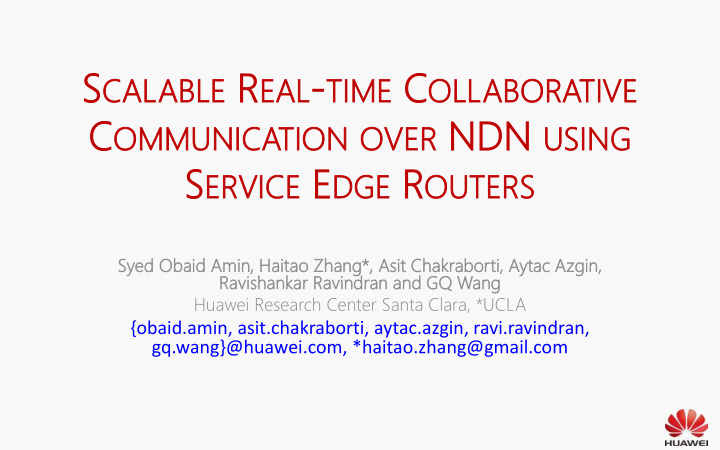



S CALABLE BLE R EAL - TIME ME C OLLABO BORA RATIVE C OMM VER ND NDN N USI MMUNI NICATION OVE SING NG S ERV CE E DGE GE R OUTE RVICE UTERS Sy Syed d Obai baid d Amin, Hai Haitao tao Zh Zhang* g*, Asit C Chakrab akraborti ti, A Aytac tac A Azgi zgin, Ravish shan ankar kar Rav avindra dran an and G d GQ Q Wan ang Huawei Research Center Santa Clara, *UCLA {obaid.amin, asit.chakraborti, aytac.azgin, ravi.ravindran, gq.wang}@huawei.com, *haitao.zhang@gmail.com
Introduction • Recently we have converted our Audio/Video conferencing application to NDN from CCNx- 0.8.2 • Reasons: – Scalability, after 12 participants (each consumes and produces the AV stream), the CCNx forwarder didn’t seem to scale well. – To experience NFD performance
Quick Revision
Application Architecture GUI based version Used for actual demo • Live feed is captured • from Camera and Microphone Headless version Used for emulation • No GUI • Emulated generation of AV • packets Goal: testing scalability •
Emulation Details using Headless Version Containers 3 Service Edge Routers • UE-7 UE-8 UE-9 … 5 host server each running 9 • Bridge (br0) containers Containers Conference Service Video traffic model was Host-3 Manager UE-4 UE-5 UE-6 • … VSER-3 derived from our earlier Bridge (br0) prototype Host-2 Containers Audio content was modeled UE-2 UE-1 • UE-3 IP Network … after G.729 codec generating Bridge (br0) VSER-2 CBR traffic of 30Kbps Host-1 VSER-1
Emulation Results Percentage of usable contents at the consumer side (packets which are not lost and arrive within the deadline) Two sets of experiments: 1. All participants are producing and consuming 2. One consumer rest of the participants act as producer Caching affords better performance even for real-time applications The 90 th percentile is <150ms and <250ms for Audio and Video Audio and video latency performance with single consumer and multiple producer Audio and video latency performance with all consumer-producer nodes nodes
The Demo Topology UE: User Entity CA: Client Agent NFD: NDN Forwarding Daemon SyncManager Proxy2 Proxy1 192.168.1.161 192.168.1.162 192.168.1.163 192.168.1.164 UE163 UE164 CA CA 7
Thanks hanks!
Backup ackup slide lides
Motivation ICN Deployment • – Caching and aggregation at the Edge – Names for service/content/device enable context aware networking – Potential for new business models for network operators Service from the Edge • – Service-centric Compute, Storage and Bandwidth scaling using virtualization – Tailor services to locality and user context (mobility, social parameters) – Minimize latency and jitter – Avoid backbone bottlenecks NFV/SDN programmability • – Enables compute and network virtualization – Allows realization of new network architectures like ICN – 5G Network Slicing using the same technologies
AV Conferencing Survey Many existing solutions support • only multi-party audio conference and 2-party video conference P2P systems: • High control signaling – overhead, complex client design Client/Server: • Centralized processing, – complex design, expensive, limited scalability IP Multicast: • Due to lack of extensive IP – multicast deployments, very few IP multicast based conferencing solutions are available “Measurement Study of Multi-party Video Conferencing”, Yue Lu, Yong Zhao, Fernando Kuipers , Piet Mieghem, in Proceedings of IFIP Networking, 2010.
Comparison of different conferencing model AV client AV client AV client AV client Edge Router Server Edge Router (NDN + (NDN + Service Service Component) Component) AV client AV client AV client AV client Centralized, IP based: Bandwidth with in the network Decentralized, ICN based: Bandwidth consumed in is O(N 2 ) Where N is the number of clients the network is O(N * R) where N is the number of clients, R is the number of Edge Routers
Simplified System Design Controller VSER (Proxy + VSER(Proxy + NFD) NFD) UE UE UE Client Agent Client Agent Client Agent AV App AV App AV App
Why NDN-based video conference NDN has built-in cache/multicast support • – Reduce network traffic IP backbone NDN backbone NDN has built-in mobility support • – No concept of end-to-end connection – Do not need to tear down old connections and set up new connections again NDN has built-in security support • – Provide a way to verify the identities of data publishers – Provide a way to secure the video data directly (do not rely on third parties) 14
Recommend
More recommend